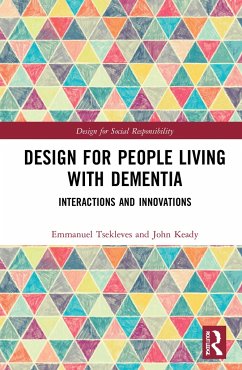- Gebundenes Buch
- Merkliste
- Auf die Merkliste
- Bewerten Bewerten
- Teilen
- Produkt teilen
- Produkterinnerung
- Produkterinnerung
This book is essential reading for healthcare managers working to provide products, services and care to people with dementia,
Andere Kunden interessierten sich auch für
![Managing to Collaborate Managing to Collaborate]() Chris HuxhamManaging to Collaborate260,99 €
Chris HuxhamManaging to Collaborate260,99 €![Business Ethics Business Ethics]() Business Ethics112,99 €
Business Ethics112,99 €![The Persuasive Negotiator The Persuasive Negotiator]() Florence Kennedy RollandThe Persuasive Negotiator195,99 €
Florence Kennedy RollandThe Persuasive Negotiator195,99 €![For Business Ethics For Business Ethics]() Campbell JonesFor Business Ethics217,99 €
Campbell JonesFor Business Ethics217,99 €![Economics of Agricultural Development Economics of Agricultural Development]() George W. NortonEconomics of Agricultural Development250,99 €
George W. NortonEconomics of Agricultural Development250,99 €![Growing your Business Growing your Business]() Gerard BurkeGrowing your Business303,99 €
Gerard BurkeGrowing your Business303,99 €![Influencer Marketing Influencer Marketing]() Duncan BrownInfluencer Marketing238,99 €
Duncan BrownInfluencer Marketing238,99 €-
-
-
This book is essential reading for healthcare managers working to provide products, services and care to people with dementia,
Hinweis: Dieser Artikel kann nur an eine deutsche Lieferadresse ausgeliefert werden.
Hinweis: Dieser Artikel kann nur an eine deutsche Lieferadresse ausgeliefert werden.
Produktdetails
- Produktdetails
- Verlag: Routledge
- Seitenzahl: 176
- Erscheinungstermin: 17. Mai 2021
- Englisch
- Abmessung: 240mm x 161mm x 14mm
- Gewicht: 435g
- ISBN-13: 9781138337398
- ISBN-10: 1138337390
- Artikelnr.: 59985573
- Herstellerkennzeichnung
- Libri GmbH
- Europaallee 1
- 36244 Bad Hersfeld
- gpsr@libri.de
- Verlag: Routledge
- Seitenzahl: 176
- Erscheinungstermin: 17. Mai 2021
- Englisch
- Abmessung: 240mm x 161mm x 14mm
- Gewicht: 435g
- ISBN-13: 9781138337398
- ISBN-10: 1138337390
- Artikelnr.: 59985573
- Herstellerkennzeichnung
- Libri GmbH
- Europaallee 1
- 36244 Bad Hersfeld
- gpsr@libri.de
Emmanuel Tsekleves is Senior Lecturer in Design Interactions at Imagination Lancaster, Lancaster University, UK. Emmanuel leads research at the intersection of design, health, well-being and technology. His design-led research attracted media attention by the national press, such as the Daily Mail, Daily Mirror, The Times, Discovery News and several other international online media outlets. He blogs regularly for The Guardian and The Conversation on the design and use of technology in health. John Keady is Professor of Older Peoples Mental Health, leading the interdisciplinary Dementia and Ageing Research Team at the University of Manchester, UK.
Foreword by Series Editor
Acknowledgements
Notes on Authors
Chapter 1: Introduction
PART 1 - Design for People Living with Dementia in Context
Chapter 2: PEOPLE: Dementia Overview
Chapter 3: CONTEXTS: Design Challenges
Chapter 4: MATERIAL: Design Research Methods
Chapter 5: THINGS: Design Interventions against Dementia
PART 2 - Case Studies
Case study 1: Open Doors: The changing face of our neighbourhood
Case study 2: MinD: Designing mindful self-empowerment and social
engagement
Case study 3: Care-Wear: garments for people living with dementia in care
homes
Case study 4: Collaborative interaction for older people with dementia
through
touch screen music
Case study 5: Designing leisure products for people living with dementia
Case study 6: "Think-Along Dwelling" for people with dementia
Case study 7: Designing interactive music systems with and for people with
dementia
Case study 8: The LAUGH project
Case study 9: Paul's Club
Case study 10: The 'in the moment' musical experiences of people with
dementia
PART 3 - Foresight
Chapter 6: The Future: Current challenges and emerging opportunities
Acknowledgements
Notes on Authors
Chapter 1: Introduction
PART 1 - Design for People Living with Dementia in Context
Chapter 2: PEOPLE: Dementia Overview
Chapter 3: CONTEXTS: Design Challenges
Chapter 4: MATERIAL: Design Research Methods
Chapter 5: THINGS: Design Interventions against Dementia
PART 2 - Case Studies
Case study 1: Open Doors: The changing face of our neighbourhood
Case study 2: MinD: Designing mindful self-empowerment and social
engagement
Case study 3: Care-Wear: garments for people living with dementia in care
homes
Case study 4: Collaborative interaction for older people with dementia
through
touch screen music
Case study 5: Designing leisure products for people living with dementia
Case study 6: "Think-Along Dwelling" for people with dementia
Case study 7: Designing interactive music systems with and for people with
dementia
Case study 8: The LAUGH project
Case study 9: Paul's Club
Case study 10: The 'in the moment' musical experiences of people with
dementia
PART 3 - Foresight
Chapter 6: The Future: Current challenges and emerging opportunities
Foreword by Series Editor
Acknowledgements
Notes on Authors
Chapter 1: Introduction
PART 1 - Design for People Living with Dementia in Context
Chapter 2: PEOPLE: Dementia Overview
Chapter 3: CONTEXTS: Design Challenges
Chapter 4: MATERIAL: Design Research Methods
Chapter 5: THINGS: Design Interventions against Dementia
PART 2 - Case Studies
Case study 1: Open Doors: The changing face of our neighbourhood
Case study 2: MinD: Designing mindful self-empowerment and social engagement
Case study 3: Care-Wear: garments for people living with dementia in care homes
Case study 4: Collaborative interaction for older people with dementia through
touch screen music
Case study 5: Designing leisure products for people living with dementia
Case study 6: "Think-Along Dwelling" for people with dementia
Case study 7: Designing interactive music systems with and for people with dementia
Case study 8: The LAUGH project
Case study 9: Paul's Club
Case study 10: The 'in the moment' musical experiences of people with dementia
PART 3 - Foresight
Chapter 6: The Future: Current challenges and emerging opportunities
Acknowledgements
Notes on Authors
Chapter 1: Introduction
PART 1 - Design for People Living with Dementia in Context
Chapter 2: PEOPLE: Dementia Overview
Chapter 3: CONTEXTS: Design Challenges
Chapter 4: MATERIAL: Design Research Methods
Chapter 5: THINGS: Design Interventions against Dementia
PART 2 - Case Studies
Case study 1: Open Doors: The changing face of our neighbourhood
Case study 2: MinD: Designing mindful self-empowerment and social engagement
Case study 3: Care-Wear: garments for people living with dementia in care homes
Case study 4: Collaborative interaction for older people with dementia through
touch screen music
Case study 5: Designing leisure products for people living with dementia
Case study 6: "Think-Along Dwelling" for people with dementia
Case study 7: Designing interactive music systems with and for people with dementia
Case study 8: The LAUGH project
Case study 9: Paul's Club
Case study 10: The 'in the moment' musical experiences of people with dementia
PART 3 - Foresight
Chapter 6: The Future: Current challenges and emerging opportunities
Foreword by Series Editor
Acknowledgements
Notes on Authors
Chapter 1: Introduction
PART 1 - Design for People Living with Dementia in Context
Chapter 2: PEOPLE: Dementia Overview
Chapter 3: CONTEXTS: Design Challenges
Chapter 4: MATERIAL: Design Research Methods
Chapter 5: THINGS: Design Interventions against Dementia
PART 2 - Case Studies
Case study 1: Open Doors: The changing face of our neighbourhood
Case study 2: MinD: Designing mindful self-empowerment and social
engagement
Case study 3: Care-Wear: garments for people living with dementia in care
homes
Case study 4: Collaborative interaction for older people with dementia
through
touch screen music
Case study 5: Designing leisure products for people living with dementia
Case study 6: "Think-Along Dwelling" for people with dementia
Case study 7: Designing interactive music systems with and for people with
dementia
Case study 8: The LAUGH project
Case study 9: Paul's Club
Case study 10: The 'in the moment' musical experiences of people with
dementia
PART 3 - Foresight
Chapter 6: The Future: Current challenges and emerging opportunities
Acknowledgements
Notes on Authors
Chapter 1: Introduction
PART 1 - Design for People Living with Dementia in Context
Chapter 2: PEOPLE: Dementia Overview
Chapter 3: CONTEXTS: Design Challenges
Chapter 4: MATERIAL: Design Research Methods
Chapter 5: THINGS: Design Interventions against Dementia
PART 2 - Case Studies
Case study 1: Open Doors: The changing face of our neighbourhood
Case study 2: MinD: Designing mindful self-empowerment and social
engagement
Case study 3: Care-Wear: garments for people living with dementia in care
homes
Case study 4: Collaborative interaction for older people with dementia
through
touch screen music
Case study 5: Designing leisure products for people living with dementia
Case study 6: "Think-Along Dwelling" for people with dementia
Case study 7: Designing interactive music systems with and for people with
dementia
Case study 8: The LAUGH project
Case study 9: Paul's Club
Case study 10: The 'in the moment' musical experiences of people with
dementia
PART 3 - Foresight
Chapter 6: The Future: Current challenges and emerging opportunities
Foreword by Series Editor
Acknowledgements
Notes on Authors
Chapter 1: Introduction
PART 1 - Design for People Living with Dementia in Context
Chapter 2: PEOPLE: Dementia Overview
Chapter 3: CONTEXTS: Design Challenges
Chapter 4: MATERIAL: Design Research Methods
Chapter 5: THINGS: Design Interventions against Dementia
PART 2 - Case Studies
Case study 1: Open Doors: The changing face of our neighbourhood
Case study 2: MinD: Designing mindful self-empowerment and social engagement
Case study 3: Care-Wear: garments for people living with dementia in care homes
Case study 4: Collaborative interaction for older people with dementia through
touch screen music
Case study 5: Designing leisure products for people living with dementia
Case study 6: "Think-Along Dwelling" for people with dementia
Case study 7: Designing interactive music systems with and for people with dementia
Case study 8: The LAUGH project
Case study 9: Paul's Club
Case study 10: The 'in the moment' musical experiences of people with dementia
PART 3 - Foresight
Chapter 6: The Future: Current challenges and emerging opportunities
Acknowledgements
Notes on Authors
Chapter 1: Introduction
PART 1 - Design for People Living with Dementia in Context
Chapter 2: PEOPLE: Dementia Overview
Chapter 3: CONTEXTS: Design Challenges
Chapter 4: MATERIAL: Design Research Methods
Chapter 5: THINGS: Design Interventions against Dementia
PART 2 - Case Studies
Case study 1: Open Doors: The changing face of our neighbourhood
Case study 2: MinD: Designing mindful self-empowerment and social engagement
Case study 3: Care-Wear: garments for people living with dementia in care homes
Case study 4: Collaborative interaction for older people with dementia through
touch screen music
Case study 5: Designing leisure products for people living with dementia
Case study 6: "Think-Along Dwelling" for people with dementia
Case study 7: Designing interactive music systems with and for people with dementia
Case study 8: The LAUGH project
Case study 9: Paul's Club
Case study 10: The 'in the moment' musical experiences of people with dementia
PART 3 - Foresight
Chapter 6: The Future: Current challenges and emerging opportunities








